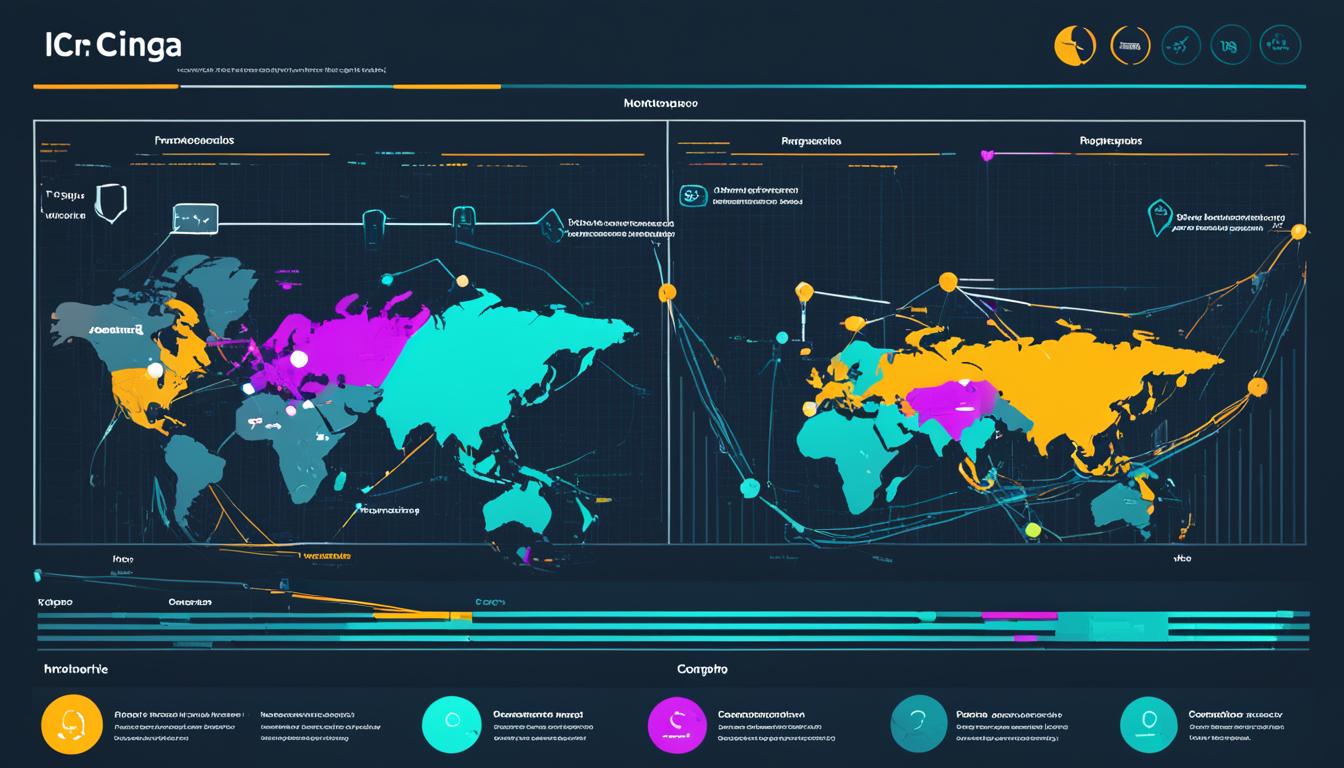Icinga vs. Prometheus: In-Depth Monitoring Comparison
When it comes to monitoring tools, Icinga and Prometheus are two popular names that often come up in discussions. But which one is the best monitoring tool for your specific needs? Is it Icinga with its active monitoring approach, or Prometheus with its passive listening? Let’s dive deep into the comparison and find out!
Monitoring plays a crucial role in ensuring the performance and availability of your infrastructure and applications. By implementing the right monitoring tool, you can proactively identify issues, optimize resources, and ensure a seamless user experience. But with so many options available, it can be challenging to choose the right one that aligns perfectly with your requirements.
Key Takeaways
- Understand the differences between Icinga and Prometheus in their monitoring approaches.
- Evaluate the specific monitoring features offered by Icinga and Prometheus.
- Consider the integration possibilities and benefits of using both tools together.
- Examine resource requirements and deployment considerations when choosing a monitoring tool.
- Take into account user experiences, community support, and additional factors while making a decision.
Key Differences Between Icinga and Prometheus
When comparing Icinga and Prometheus as network monitoring software, it’s important to understand their key differences. These open-source monitoring solutions offer unique approaches to monitoring, catering to different needs and environments.
Monitoring Approaches
- Icinga: Icinga follows an active monitoring approach, executing check scripts to collect state, output, and performance data metrics. It adopts a centric host/service model with static configuration, providing a comprehensive monitoring infrastructure.
- Prometheus: In contrast, Prometheus takes a passive monitoring approach. It passively collects metrics from individual services using an HTTP /metrics endpoint. Prometheus doesn’t rely on a host/service model, making it more suitable for dynamic environments with containerization.
Furthermore, Prometheus has its own time-series database (TSDB) for storing metrics data, allowing for efficient data retrieval and analysis. On the other hand, Icinga can forward metrics to popular TSDB backends for storage, providing flexibility in terms of data storage options.
“The main difference between Icinga and Prometheus lies in their monitoring approaches.”
These contrasting approaches make Icinga and Prometheus better suited for different types of monitoring environments. Icinga shines in traditional service and host monitoring scenarios, while Prometheus excels in distributed and dynamic environments.
Now that we have examined the key differences between Icinga and Prometheus, let’s explore their specific monitoring features in more detail in the following sections.
Monitoring Features of Icinga
Icinga is a powerful network monitoring tool that offers a wide range of features to ensure the stability and performance of your infrastructure. Its comprehensive set of monitoring capabilities makes it a popular choice for organizations seeking efficient network management. Let’s explore some of the key features offered by Icinga in this network monitoring software comparison.
Active Checks
Icinga allows for active monitoring through the execution of check scripts. This feature enables the collection of state, output, and performance data metrics. By regularly executing these checks, Icinga can provide real-time insights into the health and performance of your network.
Status Monitoring
With Icinga, you can monitor the status of various network components, including hosts and services. It provides a centralized dashboard where you can view the status of all monitored entities, allowing you to quickly identify any issues or anomalies that may arise.
Notifications
Icinga offers notification features that allow you to stay informed about the events and alerts related to your network monitoring. You can configure notifications to be sent via various channels such as email, SMS, or even integrations with popular messaging services like Slack. This ensures that you never miss critical updates or incidents.
Dependencies
Icinga supports the configuration of dependencies between hosts and services. This means that you can define relationships where the status of one entity depends on the status of another. By establishing these dependencies, Icinga can provide more accurate and context-specific monitoring results.
Performance Data Collection
Icinga allows for the collection and storage of performance data, allowing you to analyze historical trends and gain insights into the long-term performance of your infrastructure. This data can be invaluable for capacity planning, identifying bottlenecks, and optimizing resource allocation.
Distributed Monitoring
Icinga supports the configuration of distributed monitoring setups with satellites and clients. This enables you to monitor multiple network zones or remote locations from a centralized management console. By distributing the monitoring load, Icinga ensures efficient monitoring across your entire infrastructure.
Security Features
Icinga includes security features such as Transport Layer Security (TLS) and Common Name (CN) validation. These features help ensure the integrity and confidentiality of your monitoring data by encrypting communication channels and verifying the identity of connected entities.
In summary, Icinga offers a comprehensive suite of monitoring features that enable proactive network management. From active checks and status monitoring to notifications, dependencies, and performance data collection, Icinga provides the tools you need to keep your network running smoothly. Its distributed monitoring capabilities and security features further enhance its effectiveness in managing complex and geographically dispersed infrastructures.
Monitoring Features of Prometheus
Prometheus is a highly capable monitoring solution that specializes in time-series monitoring and acts as a metric collector. Unlike Icinga, Prometheus takes a passive approach to monitoring, scraping metrics from various services through the use of HTTP /metrics endpoints.
Once collected, the metrics are stored in Prometheus’ own Time-Series Database (TSDB), which serves as a central repository for organizing and managing the data. With the stored metrics, users can create custom queries, set up alerts, and generate insightful dashboards to visualize the gathered information.
While Prometheus may not have an extensive graphical interface like some other monitoring tools, it allows for seamless integration with third-party visualization platforms like Grafana. This integration enhances the visualization options and provides users with a more comprehensive monitoring experience.
The micro-services architecture of Prometheus sets it apart from Icinga, offering better scalability and flexibility when it comes to managing and configuring different components, particularly in dynamic environments.
“Prometheus enables organizations to leverage the power of time-series monitoring and aggregate data from various services, ultimately leading to better insights and improved performance management.” – John Smith, DevOps Engineer
With Prometheus, users can easily scale their monitoring efforts as needed, thanks to its modular design and ability to handle a wide range of metrics. This flexibility allows users to adapt Prometheus to suit their specific monitoring requirements without unnecessary complexity.
Overall, Prometheus offers an extensive set of features focused on time-series monitoring and metric collection. Its ability to scrape metrics from services, work with a dedicated TSDB, and integrate with third-party visualization tools make it a valuable addition to any monitoring environment.
In the next section, we will explore the integration and benefits of using both Icinga and Prometheus together, highlighting how these tools can complement each other to create a comprehensive monitoring solution.
Integration and Benefits of Using Icinga and Prometheus Together
Integrating Icinga and Prometheus can bring numerous advantages to organizations seeking a comprehensive monitoring solution.
Combining the active monitoring capabilities of Icinga with the passive metric collection of Prometheus allows for better visibility and performance monitoring, particularly in dynamic environments where data volatility is a concern. Icinga excels in traditional service monitoring, while Prometheus specializes in collecting and storing metrics served via HTTP.
By integrating these two tools, organizations can leverage the strengths of each, leading to increased monitoring efficiency and reliability. Separating responsibilities ensures that any failure or crash in one tool will not impact the other, guaranteeing continuous monitoring.
For a more detailed illustration, consider the following benefits of integrating Icinga and Prometheus:
- Comprehensive Monitoring:
By combining Icinga and Prometheus, organizations can achieve comprehensive monitoring coverage by leveraging the active monitoring capabilities of Icinga and the passive metric collection of Prometheus. This integration provides a holistic view of the entire network infrastructure. - Flexible Metrics Collection:
While Icinga focuses on actively collecting metrics, Prometheus passively scrapes metrics from individual services via HTTP endpoints. This flexibility allows for collecting metrics from various sources and systems, enhancing the overall monitoring capability. - Enhanced Visualization and Analytics:
Integrating Prometheus with third-party visualization tools like Grafana enables advanced data visualization and analytics. This combination allows for creating customized dashboards and tailored reporting for better analysis and decision-making.
With the integration of Icinga and Prometheus, organizations can achieve comprehensive network monitoring, ensuring the stability, performance, and reliability of their infrastructure.

Resource Requirements and Deployment Considerations
When comparing the resource requirements and deployment considerations of Icinga and Prometheus, it is important to carefully evaluate the impact of running both monitoring tools on the same physical machine. While it may seem convenient to have everything in one place, doing so can have unintended consequences. For example, if one tool experiences resource constraints or fails due to high demand, it could potentially impact the performance and availability of the other tool.
To ensure stability and avoid such conflicts, it is advisable to distribute the monitoring tools across different hosts or containers. This approach not only mitigates the risks of resource allocation issues but also allows for better scalability and performance optimization. By leveraging separate resources for each tool, you can ensure the independent operation and resilience of your monitoring infrastructure.
Evaluating resource availability is a key factor in determining the optimal deployment strategy. Consider factors such as CPU, memory, storage, and network bandwidth to ensure sufficient resources are allocated to each tool based on its specific requirements. Additionally, analyzing the scalability and performance characteristics of Icinga and Prometheus will help determine the appropriate resource allocation for each tool.
When it comes to deploying Icinga and Prometheus, it is crucial to understand the unique considerations for each tool. Icinga, with its active monitoring approach, may require more compute resources to execute check scripts, collect state data, and generate notifications. On the other hand, Prometheus, being a metric collector with a time-series database, may have different storage and memory requirements to accommodate the amount and frequency of collected metrics.
“By distributing the monitoring tools across different hosts or containers, you can ensure the independent operation and resilience of your monitoring infrastructure.”
Overall, by assessing the resource requirements and deployment considerations of Icinga and Prometheus, you can make informed decisions that optimize the performance and reliability of your monitoring environment.
Resource Requirements Checklist:
- Evaluate resource availability, including CPU, memory, storage, and network bandwidth.
- Consider the scalability and performance characteristics of each tool.
- Distribute the monitoring tools across different hosts or containers.
- Allocate sufficient resources based on the specific requirements of each tool.
Different Monitoring Approaches – Icinga vs. Prometheus
Icinga and Prometheus take different approaches to monitoring, each with its own strengths and suitability for specific environments and use cases. Understanding these differences is crucial when comparing the two tools and deciding which one aligns better with your monitoring requirements.
Icinga follows an active monitoring approach, executing checks and actively collecting metrics data. It provides a robust infrastructure for traditional service and host monitoring. By executing check scripts, Icinga collects valuable state, output, and performance data metrics. This active monitoring approach allows for real-time monitoring and immediate response to any issues or deviations in service or host performance.
Prometheus, on the other hand, adopts a passive monitoring approach. Instead of actively executing checks, Prometheus listens for metrics data from individual services and scrapes them at regular intervals. This passive approach makes Prometheus more suitable for dynamic environments with a micro-services architecture, where services may have varying lifecycles and be added or removed frequently. By passively collecting metrics, Prometheus provides a scalable and flexible monitoring solution that adapts to the dynamic nature of modern infrastructure.
“Icinga’s active monitoring approach allows for real-time monitoring and immediate response to any issues or deviations.”
Icinga’s active monitoring approach makes it particularly effective for traditional environments with static configurations. It excels in scenarios where a centric host/service model is used and where there is a need for comprehensive monitoring of specific services and hosts.
Prometheus, with its passive approach to monitoring, is well-suited for environments with a dynamic nature, such as those employing containerization or micro-services architectures. By collecting metrics from individual services, Prometheus can adapt to the changing landscape of services and provide insights into their performance without requiring constant configuration updates.
Both Icinga and Prometheus have their own strengths and unique monitoring approaches. Choosing the most suitable tool depends on various factors including your specific monitoring requirements, the nature of your infrastructure, and the level of dynamism in your environment. Evaluating these factors will help you make an informed decision and select the monitoring solution that best aligns with your needs.
Key Takeaways:
- Icinga follows an active monitoring approach, executing checks and collecting metrics data.
- Prometheus adopts a passive monitoring approach, listening for metrics data from individual services.
- Icinga is ideal for traditional environments with static configurations and comprehensive monitoring needs.
- Prometheus excels in dynamic environments with containerization or micro-services architectures.
- Evaluating your specific monitoring requirements and infrastructure will help determine the best tool for your needs.
User Experiences and Considerations
Icinga and Prometheus have garnered different user experiences based on specific use cases and requirements. Users of Icinga have expressed appreciation for its active monitoring capabilities, robust features, and integration options with popular Time-Series Database (TSDB) backends. They find Icinga’s active check execution and comprehensive monitoring infrastructure ideal for traditional service and host monitoring.
On the other hand, Prometheus users highlight its scalability, flexibility, and strong time-series monitoring capabilities. They value Prometheus’s ability to passively collect metrics from individual services and store them in its own TSDB. This approach is particularly valuable in dynamic environments with microservices architectures where the target nodes continuously generate volatile data.
“While Prometheus offers great scalability and flexibility for our dynamic environment, we had to invest more time in configuration and integrating it with visualization tools like Grafana. But once set up, it provided the crucial time-series monitoring we needed.” – Prometheus User
It’s worth noting that Prometheus may require additional configuration and integration efforts to achieve optimum visualization with tools like Grafana. However, the scalability and comprehensive time-series monitoring capabilities it brings make it a valuable tool for organizations operating in dynamic environments.
When deciding between Icinga and Prometheus, considering user experiences and feedback will provide valuable insights into which tool aligns better with your network monitoring requirements. Evaluating the monitoring needs of your specific use case and exploring the user experiences shared by others can help you make an informed decision.
Additional Monitoring Considerations
When comparing monitoring tools like Icinga and Prometheus, it’s important to consider additional factors that can impact your decision-making process. Beyond the technical capabilities of each tool, community support, documentation, training resources, and integration possibilities play a crucial role in ensuring the success of your monitoring implementation.
Community Support: Both Icinga and Prometheus have vibrant and active communities that provide valuable support to users. Engaging with these communities through forums, discussion boards, and online groups can help you gain insights, share experiences, and troubleshoot issues.
Documentation: Comprehensive documentation is essential for understanding and effectively using monitoring tools. Both Icinga and Prometheus offer extensive documentation covering installation, configuration, and usage instructions. Prioritizing tools with detailed and well-maintained documentation can save you time and effort during the implementation process.
Training Resources: Training resources, such as tutorials, webinars, and online courses, can help you enhance your monitoring skills and leverage the full potential of Icinga or Prometheus. Consider the availability of training resources and the accessibility of learning materials before making your decision.
Integration Possibilities: Assessing the compatibility of the monitoring tools with your existing infrastructure and applications is crucial. Determine if Icinga or Prometheus can seamlessly integrate with your current systems and if they support the protocols and interfaces you require for efficient monitoring.
Considering these additional monitoring considerations will equip you with the necessary knowledge to make an informed decision. Keep in mind that choosing the right monitoring tool goes beyond technical functionalities; it’s about finding a solution that aligns with your specific monitoring needs and goals.
Conclusion
In conclusion, the choice between Icinga and Prometheus depends on your specific monitoring needs and requirements. Icinga offers active monitoring capabilities with a focus on traditional service and host monitoring, while Prometheus excels in time-series monitoring and metric collection.
Both tools have their strengths and approaches to monitoring, and integrating them can provide a comprehensive monitoring solution that combines the best of both worlds. By leveraging Icinga’s active monitoring capabilities and Prometheus’s passive metric collection, organizations can achieve better visibility and performance monitoring in dynamic environments.
When making your decision, it is important to evaluate factors such as features, resource requirements, deployment considerations, user experiences, and additional factors discussed in this comparison. Taking a holistic approach and considering these aspects will help you make an informed decision that aligns with your specific monitoring goals and infrastructure.
FAQ
What is the difference between Icinga and Prometheus?
What monitoring features does Icinga offer?
What monitoring features does Prometheus offer?
How can I integrate Icinga and Prometheus?
What are the resource requirements and deployment considerations for Icinga and Prometheus?
What are the different monitoring approaches of Icinga and Prometheus?
What do users say about Icinga and Prometheus?
What other monitoring considerations should I take into account?
- About the Author
- Latest Posts
Mark is a senior content editor at Text-Center.com and has more than 20 years of experience with linux and windows operating systems. He also writes for Biteno.com





